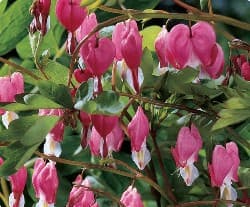How to Grow Bleeding Heart Flowers

Growing Bleeding Heart Flowers in Your Home Garden
Bleeding Hearts are both attractive plants and attractive flowers. There aren’t many flowering shade-loving plants. And, most shade-loving plants are grown for their attractive foliage However, you will love the colorful blooms of perennial Bleeding Heart flowers, too. The flowers are long-lasting. Use this guide on “How to Grow Bleeding Heart Flowers”, and you’re on your way to a beautiful, flowering shade garden.
Bleeding Heart plants are native to woodlands of the U.S. and Canada. They are shade-loving plants, that grow and bloom best in cool weather. The plants grow 1 to 3 feet, depending upon variety. Heart-shaped flowers with a showy stamen, bloom from spring to summer.
The plants look great in shade gardens and natural woodland settings. The smaller varieties look great in flowerpots on your patio or deck.
Bleeding Hearts are deer resistant. But, Hummingbirds are attracted to them.
In Japanese folklore, the flower represents love and loyalty.
Blooms make nice, long-lasting cut flowers.
Plant Specifications
Flower Colors: The most common colors are pink and white. You may also find red, rose, yellow, and purple, too.
Flowers Bloom: Spring to summer
Plant Height: Six inches to three feet, depending upon variety.
Ideal Soil pH: 6.0 – 7.5.
Plant Hardiness Zones: 3 through 9.
Sunlight Needs: Partial sun to shade
Toxicity: All parts of this plant are poisonous.
Native to: U.S. and Canada
Plant Type: Perennial
Botanical Name: Lamprocapnos spectabilis
Other Names: This plant is also called the Valentine Flower.
Are Bleeding Heart Plants Edible?
NO!!
The plant causes skin rash and irritation. And, it can be toxic if ingested in large quantities. Keep this plant away from children and pets. They are harmful to farm animals, too.
Bleeding Heart Plant Medicinal Uses
- It is used to treat congestive heart failure.
- It helps to lower blood pressure.
- The alkaloid in the plant has diuretic properties.
- Treats menstrual cramps and other gynecological ailments.
- It is also used as a topical treatment of aches and pains.
Perennial Bleeding Hearts Plant Propagation
Bleeding Heart perennials are propagated through rhizomes (their roots). Planting and transplanting is best performed in cooler spring weather. They can be separated through division. Dig up rhizomes and separate them. Make sure that each segment has an eye or two.
The flowers produce seeds, too. They are good reseeders if left to grow in the spot. Despite this trait, they are not an invasive plant. Few people grow them from seed. Propagating the plants using their rhizomes is much easier.
You also have a third option to propagate these plants. Take a cutting and root it in a growing medium. Keep the soil or medium moist to encourage the growth of roots.
How to Grow Bleeding Heart Flower Plants
Bleeding Heart plants are easy to grow. Native to woodland settings, they grow their best in cooler regions where air temperatures are usually 75° F or less. The plants grow best in partial shade. Yet, they do very well in heavier shade, too. They can be grown in the sun, in cooler areas. However, pre-mature dormancy can occur in warm weather under full sunlight.
The soil should be rich and well-draining. Mix in a healthy amount of compost when first planting them. They like consistently moist soil.
Fertilize plants regularly, especially if the soil is not rich. It is important to keep the soil moist, not wet or soggy.
Much around plants to help retain soil moisture. As the mulch decomposes, it will help to nourish the plants.
The plants will bloom in the spring. In cooler areas, they may rebloom as summer nears. In warmer regions, it is not uncommon for the plants to go dormant in the mid-summer heat. The plants and especially the flower stalks are susceptible to falling over in windy areas. Provide a windbreak, as needed. Also, you can stake the taller growing varieties..
Overcrowded plants result in no blooms, delayed blooms, or smaller flowers. Lift up the roots, divide them and replant them wider apart.
Like many spring bulbs, it is not uncommon to see this plant die off in hot summer weather. However, the rhizomes underground are still vibrant and the plant will regrow the next spring. If the plant continues to grow into the Fall months, cut them back to 1 – 2 inches above the ground after the first killing frost. In colder regions, a thick layer of mulch or straw will help to protect the rhizomes from freezing during harsh winters.
Pruning Bleeding Heart Plants
Pruning is not required. However, like with other plants, remove and dead, diseased or unsightly leaves and stems.
It’s your choice whether to deadhead spent blooms. Do not prune spent flowers if you want them to reseed the area.
Insect and Plant Disease Problems
Aphids, scale, slugs and snails can be an occasional problem. If you spot insects on the plants, treat them immediately with an insecticide or insecticidal soap. Use slug and snail bait as needed.
Powdery mildew and leaf spot can occur in wet, humid weather. Treat with a fungicide as needed. If there is a significant amount of disease on a plant, pull it and discard the affected plant.
Root rot can occur if the soil is wet or soggy for an extended period of time.
Also see: Plant Problems – causes and cures.
Please support our site. Shop for:
- rmmatthews100@hotmail.com
- 585-721-6528
- Rochester, NY
©1999-2024 GardenersNet.Com, All Rights Reserved

